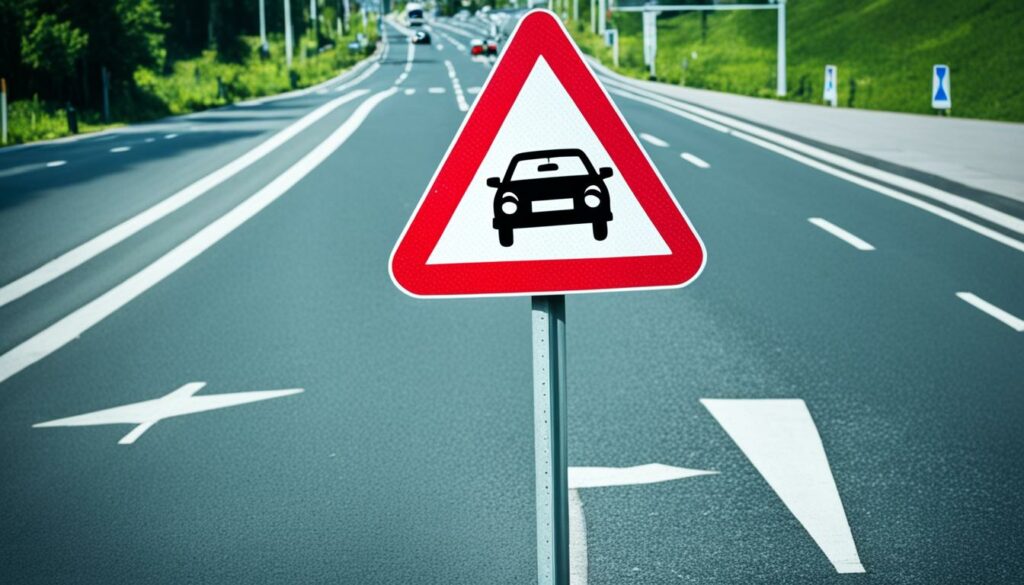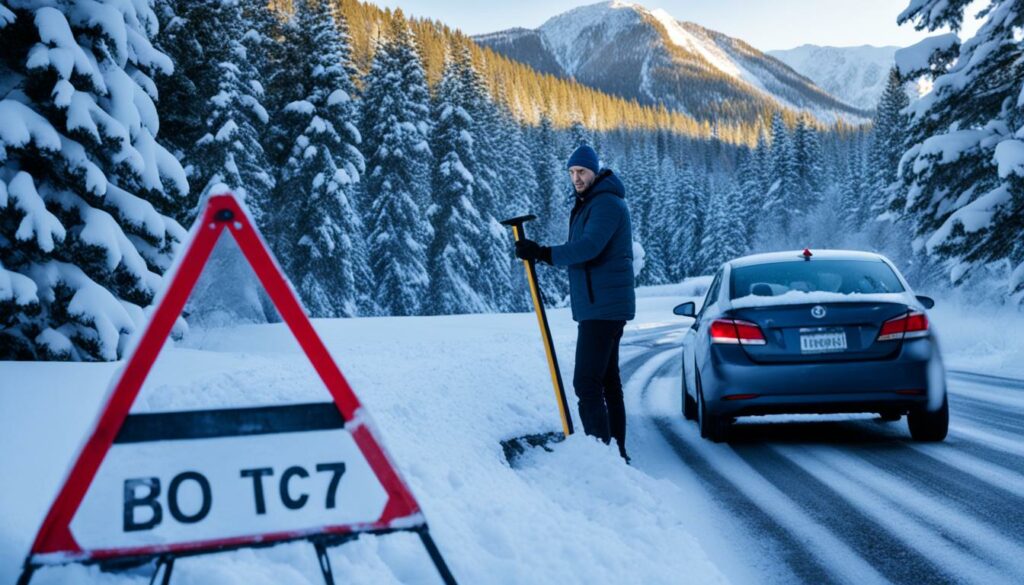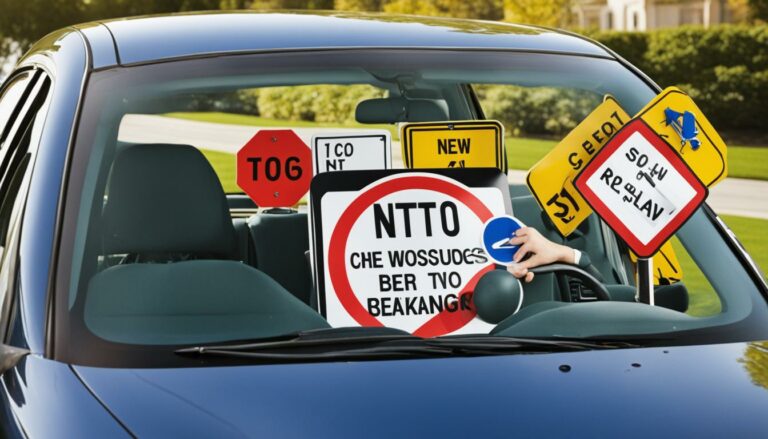Is It Okay to Drive? Safety Tips and Guidelines
Driving safely should always be a top priority for every driver. Whether you’re a seasoned driver or a new driver eager to hit the road, it’s important to understand the ins and outs of safe driving to ensure responsible and lawful behavior behind the wheel.
Before we dive into the safety tips and guidelines, let’s clarify a few essentials. Firstly, it’s important to know if you have the driving permission to get behind the wheel. In the United States, driving eligibility is determined by factors such as the legal driving age and possessing a valid driver’s license. Understanding these requirements is key to ensuring you’re legally allowed to drive.
Now that we have the basics covered, let’s explore some safety tips and guidelines that will help you navigate the roads safely and responsibly.
Key Takeaways:
- Driving safely should always be a top priority for every driver.
- Understand the legal requirements for driving permission, including the legal driving age and possessing a valid driver’s license.
- Stay informed about road safety laws and regulations in your area.
- Never drive under the influence of alcohol or drugs.
- Winter driving requires additional caution and preparation.
Safe Driving Tips

When it comes to ensuring road safety, following safe driving tips is essential. By adopting responsible driving practices, you can protect yourself and others on the road. Here are some key tips to help you drive safely:
- Keep your focus on the road: Ignoring distractions, like using your phone or eating, is one of the most crucial safe driving practices. By staying focused on the road, you can react quickly to unexpected situations and avoid accidents.
- Avoid speeding: Speeding not only violates road safety laws but also reduces your reaction time and increases the severity of accidents. Always adhere to the posted speed limits and adjust your speed according to the road conditions.
- Practice defensive driving: Defensive driving involves anticipating the unpredictable actions of other drivers and being prepared to react accordingly. By maintaining a safe following distance, using your signals, and being aware of your surroundings, you can minimize the risk of collisions.
Distractions on the Road
Distracted driving is a significant cause of accidents. According to the National Highway Traffic Safety Administration (NHTSA), in 2019, approximately 3,142 people were killed in distracted driving crashes in the United States alone. It’s important to be aware of common distractions and take measures to avoid them:
- Cell phone usage: Using your phone while driving is not only illegal but also incredibly dangerous. Put your phone on silent mode or keep it out of reach to resist the temptation of checking notifications or answering calls while driving.
- Eating and drinking: Enjoying a meal or indulging in a beverage while driving may seem harmless, but it diverts your attention from the road. It’s best to eat and drink before or after your journey, or find a safe place to pull over if necessary.
- Passengers and pets: Interacting with passengers or having unrestrained pets can be distracting. Keep conversations and interactions to a minimum while driving, and ensure that pets are properly secured for everyone’s safety.
Remember, no text or phone call is worth risking your life or the lives of other road users. It can wait!
Importance of Defensive Driving
Defensive driving is not only about obeying road safety laws but also about being proactive and prepared for unexpected situations. By adopting defensive driving techniques, you can greatly reduce the risk of accidents. Here are some key aspects of defensive driving:
- Anticipate potential hazards: Constantly scan your surroundings and be aware of other drivers’ behavior. By anticipating potential hazards, you can react quickly and take the necessary precautions to avoid accidents.
- Maintain a safe distance: Always maintain a safe following distance from the vehicle in front of you. This provides you with enough time to react to sudden stops or maneuvers.
- Use your mirrors effectively: Regularly check your rearview and side mirrors to be aware of the positions of other vehicles. This helps you make informed decisions while changing lanes or making turns.
By following these safe driving tips and practicing defensive driving, you can significantly reduce the risk of accidents and ensure a safe driving experience for yourself and others on the road.
Road Safety Laws

As a responsible driver, it is crucial to have a clear understanding of the road safety laws and regulations in your area. These laws are in place to ensure the safety of both drivers and pedestrians on the road. By following these laws, you contribute to a safer driving environment for everyone.
Key Road Safety Laws:
| Laws | Description |
|---|---|
| Not passing a stopped bus displaying a stop sign | This law is designed to protect children who may be boarding or exiting a school bus. |
| Completely stopping at stop signs | Stopping completely at stop signs ensures that you yield the right-of-way and prevents collisions. |
| Obeying the posted speed limits | Adhering to speed limits is essential for maintaining control of the vehicle and reducing the risk of accidents. |
| Following parking restrictions | Parking restrictions help organize traffic flow, ensure clear visibility, and maintain pedestrian safety. |
Meeting the eligibility requirements for driving is equally important. This includes being of the legal driving age and possessing a valid driver’s license. Adhering to these requirements ensures that drivers have the necessary skills and knowledge to operate a vehicle safely on public roads.
Remember, road safety laws are put in place to protect everyone on the road. By following these laws and meeting the necessary requirements, you contribute to creating a safer and more responsible driving culture.
Driving Under the Influence (DUI)

Driving under the influence of alcohol is a serious offense with severe consequences. It not only puts your life at risk but also endangers the lives of others on the road. DUI refers to operating a motor vehicle while impaired by alcohol or drugs. Alcohol impairs reflexes, coordination, judgment, and reaction time, compromising your ability to control a vehicle safely.
The legal blood alcohol concentration (BAC) limit is set at 0.08% in all 50 states, which means driving with a BAC of 0.08% or higher is illegal. It is important to note that different BAC limits apply to certain individuals. Commercial drivers, for example, have a lower limit of 0.04%, while individuals under the age of 21 have a zero-tolerance policy, meaning that any trace of alcohol can lead to legal consequences.
DUI arrests can have severe and long-lasting consequences. In addition to putting your life and the lives of others at risk, you may face jail time, hefty fines, mandatory rehabilitation programs, and a suspended driver’s license. The impact of a DUI conviction goes beyond legal penalties, as it can affect your employment prospects, insurance rates, and personal relationships.
It is essential to understand that driving under the influence is not worth the risk. Always remember to plan for a sober ride if you are going to consume alcohol. Utilize designated drivers, public transportation, ride-sharing services, or alternative transportation options to ensure a safe journey home. If you suspect someone is driving under the influence, report them to law enforcement immediately.
“The consequences of driving under the influence can be tragic and irreversible. Don’t risk your life and the lives of others. Always choose a safe and sober ride.”
By making responsible choices and staying sober behind the wheel, we can work together to eliminate the dangers of driving under the influence and create safer roads for everyone.
Impaired Driving Consequences
| Consequences of Impaired Driving | Description |
|---|---|
| Jail Time | Convictions for DUI often carry jail sentences, ranging from a few days to several years depending on the severity of the offense and prior convictions. |
| License Suspension | Driving privileges may be suspended or revoked for a specific period, leaving individuals without the legal ability to operate a motor vehicle. |
| Fines | Significant monetary penalties are imposed on individuals convicted of DUI, with amounts varying based on the jurisdiction and severity of the offense. |
| Mandatory Education or Rehabilitation Programs | Convicted individuals may be required to attend alcohol or drug education programs or complete rehabilitation programs to address substance abuse issues. |
| Ignition Interlock Devices | In some cases, individuals may be required to install ignition interlock devices on their vehicles, which prevent operation if alcohol is detected in the breath. |
| Increased Insurance Rates | A DUI conviction often leads to higher insurance premiums, as insurers consider impaired driving as a high-risk behavior. |
Remember, always prioritize road safety and make responsible decisions. Avoid driving under the influence, and encourage others to do the same. Together, we can create a safer environment on our roads.
Winter Driving Safety Tips

Winter conditions bring unique challenges for drivers. Snowy and icy roads, reduced visibility, and vehicles struggling to maintain traction make it crucial to take extra caution while driving in winter. To ensure road safety and minimize risks, follow these essential winter driving safety tips:
- Buckle up: Always wear your seat belt properly and make sure all passengers are buckled up as well. Seat belts save lives and protect you in the event of an accident.
- Check weather reports: Before heading out, check weather reports for updates on road conditions, winter storm warnings, and potential hazards in your area. This information will help you plan your journey accordingly.
- Keep an emergency kit in your car: Prepare for any unforeseen circumstances by keeping an emergency kit in your car. This kit should include essential items such as a blanket, flashlight, extra batteries, water, non-perishable food, ice scraper, jumper cables, and a small toolset.
- Ensure a fully charged cell phone: In case of emergencies, it’s crucial to have a fully charged cell phone with you. Keep it within reach and have emergency numbers programmed for quick access.
- Drive attentively: Maintain focus on the road and avoid distractions while driving in winter conditions. This includes avoiding phone use, eating, or engaging in any other activities that take your attention away from the road.
By following these winter driving safety tips, you can navigate the hazards of winter roads with confidence and reduce the risk of accidents. Stay vigilant, stay prepared, and prioritize your safety on the road.
Winter Driving Safety Infographic
Seat Belt and Child Safety

Ensuring the safety of everyone on the road is of utmost importance. One essential aspect of road safety is the proper use of seat belts. Studies have consistently shown that wearing a seat belt reduces the risk of death in a car crash by an astounding 60%. That’s why it’s crucial to always wear a seat belt properly and insist that everyone in the vehicle, including passengers in the back seat, is properly restrained. It takes just a few seconds to buckle up, and it can save lives.
But let’s not forget about the youngest passengers – children. Protecting children in motor vehicles is vital, and proper car seat usage should never be overlooked. It is estimated that proper car seat use reduces the risk of injury by up to 71% for infants and 54% for toddlers. When choosing a car seat, be sure to consider the age and size of your child to ensure the appropriate seat is selected. Always follow the manufacturer’s instructions for installation and use, and periodically check for recalls to ensure the safety of your child.
Remember, using appropriate car seats and boosters for children significantly reduces the risk of injury or death in a crash. Be a responsible driver and prioritize child safety on the road. By following these safety measures, we can create a safer environment for everyone.
Key Takeaways:
- Wearing seat belts reduces the risk of death in a car crash by 60%.
- Everyone in the vehicle should be properly restrained, including back-seat passengers.
- Using appropriate car seats and boosters significantly reduces the risk of injury or death for children.
- Choose the right car seat based on your child’s age and size, and follow the manufacturer’s instructions for installation and use.
Avoiding Distracted and Impaired Driving
Distracted driving is a dangerous practice that can result in severe consequences. Engaging in activities such as using cell phones, CDs, or consuming coffee while driving diverts attention away from the road, increasing the risk of accidents. It is crucial to prioritize safety and avoid these distractions to ensure a focused and attentive driving experience.
Similarly, impaired driving, whether due to alcohol or drugs, poses significant threats to the safety of everyone on the road. Impaired drivers experience reduced reflexes, impaired judgment, and compromised motor skills, making them more prone to accidents. The consequences of impaired driving can be devastating, leading to injuries, fatalities, and legal repercussions.
It is vital to never drive under the influence and make responsible decisions when it comes to alcohol or drug consumption. Planning for alternate transportation options after consuming alcohol is essential to prevent impaired driving. By choosing designated drivers, utilizing ride-sharing services, or relying on public transportation, individuals can prioritize their safety and the safety of others.
Report any suspected impaired drivers to law enforcement. By doing so, you contribute to the prevention of accidents and potential harm to innocent road users. Remember, it is our collective responsibility to create a safe driving environment and protect lives.
| Distracted Driving | Impaired Driving | Consequences |
|---|---|---|
| Using cell phones | Alcohol or drug | Increased risk of accidents |
| Other distractions (e.g., CDs, coffee) | Reduced reflexes and impaired judgment | Injuries, fatalities, legal repercussions |
| Compromised motor skills |
Defensive Driving and Sharing the Road
Defensive driving is a crucial skill that every driver should possess to prevent accidents and promote road safety. It involves being vigilant and proactive, anticipating the unexpected, and maintaining a safe following distance.
When practicing defensive driving, it’s essential to stay focused on the road and remain aware of other drivers’ actions. This includes observing their speed, signaling, and potential signs of reckless behavior. By being attentive and proactive, you can react quickly to avoid potential collisions and ensure your own safety.
Sharing the road with various road users, such as pedestrians, cyclists, and commercial trucks, is another aspect of responsible driving. It requires special consideration and adherence to the appropriate rules and regulations.
Being a courteous and patient driver:
- Leaves enough space when passing cyclists and allows them adequate room to maneuver.
- Yields to pedestrians at crosswalks and respects their right of way.
- Gives large vehicles, such as trucks or buses, extra space and time to maneuver.
Remember, defensive driving and sharing the road contribute to a safer and more harmonious driving environment for all road users.
Defensive Driving Tips:
- Always expect the unexpected and be prepared to react.
- Maintain a safe following distance, allowing enough time to brake and avoid collisions.
- Check your mirrors frequently to be aware of other vehicles around you.
- Use your turn signals to communicate your intentions to other drivers.
- Minimize distractions in the car, such as cell phone use or eating, to stay focused on the road.
- Observe and follow all traffic laws and regulations.
- Keep updated on road conditions and adjust your driving accordingly.
By practicing defensive driving and being considerate of others on the road, we can all contribute to a safer driving experience for everyone.
“Defensive driving is not only about protecting yourself; it’s about looking out for the well-being of others on the road.” – Emily Johnson, Road Safety Expert
| Tips for Sharing the Road | |
|---|---|
| 1. Be attentive: Pay close attention to your surroundings and anticipate the actions of other road users. | 2. Give space: Provide enough room for cyclists, pedestrians, and large vehicles to ensure their safety. |
| 3. Yield to pedestrians: Respect crosswalks and give pedestrians the right of way. | 4. Communicate: Signal your intentions to other drivers and use your horn sparingly. |
| 5. Be patient: Avoid aggressive driving behavior and remain patient when sharing the road. | 6. Follow road signs: Adhere to speed limits and other road signs to maintain a safe environment. |
Conclusion
Responsible driving and practicing safe driving habits are paramount to ensuring road safety. It is crucial for every driver to prioritize road safety, diligently follow the rules and regulations, and remain vigilant of potential risks and dangers on the road.
By incorporating the safe driving tips and guidelines discussed in this article, drivers can actively contribute to creating a safer and more responsible driving culture. Remember, each individual on the road has a role to play in maintaining road safety.
Let’s all commit to responsible driving, prioritize road safety, and embrace safe driving practices. Together, we can make our roads safer for everyone and prevent unnecessary accidents. Stay alert, be considerate of others, and always prioritize the well-being of yourself and fellow road users. Safe travels!
FAQ
Is it okay to drive?
Driving is generally allowed as long as you meet the eligibility requirements, such as the legal driving age and having a valid driver’s license. However, it is important to prioritize safety and follow road regulations and safety guidelines.
What are some safe driving tips?
Safe driving tips include avoiding distractions, such as using your phone, and maintaining focus on the road. It is also important to drive within the posted speed limits, practice defensive driving by anticipating other drivers’ actions, and follow road safety laws and regulations.
What are the road safety laws?
Road safety laws include not passing a stopped bus displaying a stop sign, completely stopping at stop signs, obeying posted speed limits, and following parking restrictions. Adhering to these laws ensures the safety of both drivers and pedestrians on the road.
What are the consequences of driving under the influence (DUI)?
Driving under the influence of alcohol is extremely dangerous and illegal. It impairs reflexes and mental acuity, compromising the ability to control a vehicle safely. DUI arrests can result in severe consequences, including jail time, suspended driver’s license, and fines. It is essential to never drive after consuming alcohol and to report impaired drivers to law enforcement.
What are some winter driving safety tips?
Winter driving poses unique challenges, such as snowy and icy roads, reduced visibility, and vehicles struggling to maintain traction. Safety tips include checking weather reports before traveling, keeping an emergency kit in the car, ensuring a fully charged cell phone, and driving attentively. These precautions will help drivers navigate the hazards of winter roads safely.
Why is wearing a seat belt important?
Wearing a seat belt is crucial for road safety. Studies have shown that wearing a seat belt reduces the risk of death in a car crash by 60%. It is important to always wear a seat belt properly and ensure that everyone in the vehicle is properly restrained. Additionally, protecting children in motor vehicles is vital, and using appropriate car seats and boosters significantly reduce the risk of injury or death in a crash.
Why should distracted and impaired driving be avoided?
Distracted driving, such as using cell phones or consuming coffee while driving, can pose serious risks. It is crucial to avoid these distractions and stay focused on the road. Similarly, driving while impaired by alcohol or drugs is extremely dangerous and illegal. Impaired driving leads to a high number of fatalities every year. It is important to never drive under the influence and plan for alternate transportation options if drinking. Reporting impaired drivers to law enforcement can also help prevent accidents.
What is defensive driving and why is it important?
Defensive driving is an essential skill that helps prevent accidents. It involves being aware of other drivers’ actions, expecting the unexpected, and maintaining a safe following distance. Additionally, sharing the road with other road users, such as pedestrians, cyclists, and commercial trucks, requires special consideration. Being attentive, giving them space, and following the appropriate rules and regulations ensure a safer road environment for everyone.
How can I practice responsible driving?
Responsible driving involves prioritizing road safety, following the rules and regulations, and being aware of potential risks and dangers on the road. By following the tips and guidelines provided in this article, drivers can contribute to a safer and more responsible driving culture. Remember, everyone on the road plays a part in maintaining road safety.







